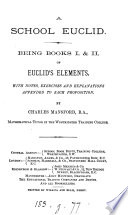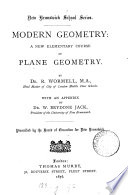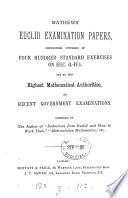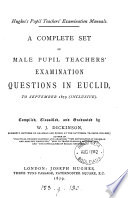 | Edward Atkins - 1874 - 426 pages
...COROLLARY. — Hence every equiangular triangle is also equilateral. Proposition 7. — Theorem. Upon the same base, and on the same side of it, there cannot be two triangles that have their sides, which are terminated in one extremity of the base, equal to one another, and... | |
 | Henry Evers - 1874 - 216 pages
...figure that cannot alter its form without altering the length of its sides. It is Euclid I., 7. " Upon the same base, and on the same side of it, there cannot be two triangles which have their two sides terminated in one extremity on the base equal, and likewise those terminated... | |
 | Euclides - 1874 - 120 pages
...sides BA, CA do not coincide with the sides ED, FD, but have a different situation as EG, FG; then on the same base and on the same side of it there will be two triangles having their sides which are terminated in one extremity of the base equal to... | |
 | Richard Wormell - 1876 - 268 pages
...28 3. From the greater of two given straight lines to cut off a part equal to the less. 28 7. Upon the same base and on the same side of it, there cannot be two triangles that have their sides terminated in one extremity of the base equal to one another, and likewise those... | |
 | Henry Major - 1876 - 784 pages
...From its provisions show what were the chief abuses of the Government under the Plantagenets ? 1. Upon the same base, and on the same side of it, there cannot be two triangles that have their sides which are terminated in one extremity of the base, equal to one another, and... | |
 | Edward Atkins - 1876 - 130 pages
...CE — DB. /ADC. BDC> VCD. ^BCD. ZBDC = and> /BCD. i KCD = (. t'DC. Proposition 7. — Theorem. Upon the same base, and on the same side of it, there cannot bs two triangles tJiat have their sides, which are terminated in one extremity of the base, equal to... | |
 | Euclides - 1877 - 58 pages
...CA do not coincide with the sides ED, FD, they wil have a different situation as EG, FG : but then on the same base and on the same side of it there will be two triangles having their sides which are terminated in the one extremity of the base equal... | |
 | Stephen Thomas Hawtrey - 1878 - 202 pages
...method, with the aid of the following explanation. Euclid proves first, in the seventh Proposition, that on the same base and on the same side of it there cannot be two triangles, having the two sides ending in one extremity of the base equal to each other, and likewise the two sides ending... | |
 | Edward Harri Mathews - 1879 - 94 pages
...straight line. t Draw the figure for the case where the given point is in the straight line produced. 3. On the same base, and on the same side of it, there cannot be two triangles which have their sides, which are terminated in one extremity of the base, equal to one another, and... | |
 | W J. Dickinson - Geometry - 1879 - 44 pages
...What proposition is the converse of this. Show that every equiangular triangle is equilateral. 7. Upon the same base and on the same side of it there cannot be two triangles that have their sides which are terminated in one extremity of the base equal to one another, and likewise... | |
| |